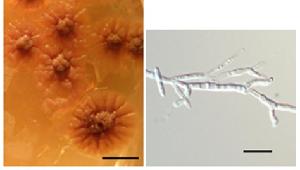
The monotypic genus Ceraceosorus B.K. Bakshi was first
described in 1976 (Cunningham et al., 1976). The type species
C. bombacis was discovered on a Bombax ceiba leaf
(Malvaceae) in Dehra Dun, India. The fungus was described as
forming a sorus-like fructification on the lower surface of the
leaf to produce discharged basidiospores. The hyphae were branched,
septate and lacked clamp connections (Cunningham et al., 1976).
After the first discovery, there have been no subsequent reports of
Ceraceosorus in nature.
The Ceraceosorus guamensis isolate (MCA4658)
selected for genome sequencing was isolated from an asymptomatic
leaf phylloplane in Guam. The fungus forms light to dark brown,
cerebriform, crusty colonies on a potato dextrose agar (PDA).
Microscopically, the fungus forms branched, septate hyphae without
clamp connections. Fusiform-shaped conidia are produced at the tip
of the hypha. Based on rDNA sequence comparisons, the genome
isolate is a sister to C. bombacis, but sequence
differences and examination of the type material suggest that the
genome strain represents an undescribed species of
Ceraceosorus, now named Ceraceosorus guamensis
sp. nov. (Kijpornyongpan and Aime, 2016). Originally, the genus
Ceraceosorus was included in Exobasidiales based on septum
ultrastructure and presence of local interaction zones within a
host cell (Begerow et al., 2006). However, subsequent molecular
sequence analyses do not support the close relationship of
Ceraceosorus with Exobasidiales or any other orders in
Ustilaginomycotina. Thus, the new order Ceraceosorales was
proposed, and its phylogenetic position remains unresolved (Begerow
et al., 2006).
The genome sequence of Ceraceosorus guamensis sp. nov.
will provide the first whole genome reference sequence for a member
of Ceraceosorales. Researchers will use these data in phylogenetic
and phylogenomic reconstructions and in comparative genomics
studies that seek to elucidate the molecular bases governing
production of sexual and anamorphic states and the evolution of
phytopathogenicity in Ustilaginomycotina.
References:
Begerow D, Stoll M, Bauer R. 2006. A phylogenetic hypothesis of Ustilaginomycotina based on multiple gene analyses and morphological data. Mycologia 98(6):906–916.
Cunningham J, Bakshi BK, Lentz PL, Gilliam MS. 1967. Two new genera of leaf-parasitic fungi (Basidiomycetidae: Brachybasidiaceae). Mycologia 68(3): 640–654.
Kijpornyongpan T, Aime MC. 2016. Rare or rarely detected? Ceraceosorus guamensis sp. nov.: a second described species of Ceraceosorales and the potential for underdetection of rare lineages with common sampling techniques. Antonie van Leeuwenhoek 109:1127-1139
Genome Reference(s)
Kijpornyongpan T, Mondo SJ, Barry K, Sandor L, Lee J, Lipzen A, Pangilinan J, LaButti K, Hainaut M, Henrissat B, Grigoriev IV, Spatafora JW, Aime MC
Broad Genomic Sampling Reveals a Smut Pathogenic Ancestry of the Fungal Clade Ustilaginomycotina.
Mol Biol Evol. 2018 Aug 1;35(8):1840-1854. doi: 10.1093/molbev/msy072
